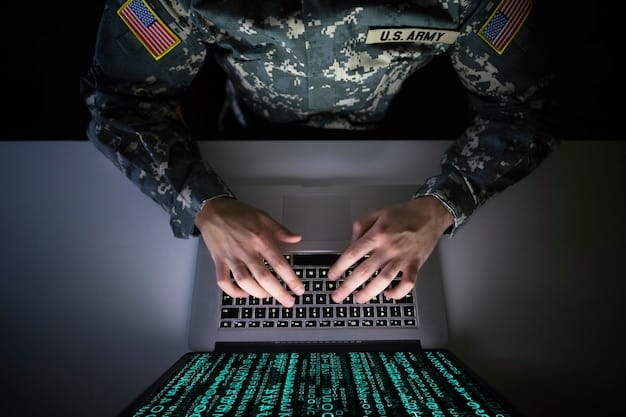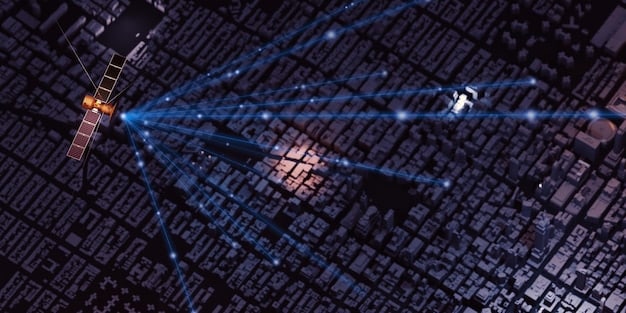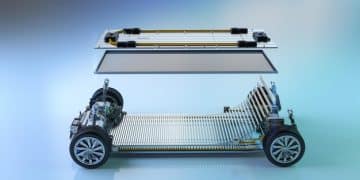AI in Defense: How the US Military Uses Artificial Intelligence

The US Military is increasingly leveraging artificial intelligence (AI) in various defense systems, enhancing capabilities in areas such as autonomous vehicles, cybersecurity, intelligence analysis, and predictive maintenance to maintain a strategic advantage.
Artificial intelligence (AI) is no longer a futuristic concept; it’s a present-day reality transforming various sectors, including national defense. The US Military is at the forefront of integrating AI into its defense systems, seeking to enhance its capabilities and maintain a strategic advantage. Let’s delve into how the US Military is utilizing artificial intelligence in defense systems.
The Rise of AI in Military Applications
Artificial intelligence has emerged as a transformative technology with the potential to revolutionize military operations. Its ability to process vast amounts of data, make predictions, and automate tasks makes it an invaluable asset for modern defense systems. The US Military is actively exploring and implementing AI solutions to enhance its capabilities across various domains.
Enhancing Decision-Making
AI can significantly improve the speed and accuracy of decision-making processes in the military. By analyzing data from multiple sources, AI algorithms can provide commanders with real-time insights, allowing them to make more informed decisions in complex and dynamic environments.
Improving Situational Awareness
AI-powered systems can enhance situational awareness on the battlefield. By processing data from sensors, satellites, and other sources, AI can create a comprehensive picture of the operational environment, enabling soldiers to identify threats and react more effectively.
- 🤖 AI algorithms analyze real-time data to quickly identify threats.
- 🛰️ AI improves the processing of intelligence from various sources.
- 🛡️ Predictive analytics helps anticipate enemy movements.
The integration of artificial intelligence is not merely about automating existing processes; it’s about fundamentally changing how the military operates and makes decisions.

Autonomous Systems and Robotics
Autonomous systems and robotics are among the most prominent applications of AI in the military. These technologies offer significant advantages in terms of reducing risk to soldiers, increasing operational efficiency, and performing tasks that are too dangerous or difficult for humans.
Unmanned Aerial Vehicles (UAVs)
UAVs, or drones, are widely used by the US Military for reconnaissance, surveillance, and strike missions. AI algorithms enable UAVs to navigate autonomously, identify targets, and coordinate with other systems. These drones are becoming increasingly sophisticated with AI capabilities, allowing for more complex missions.
Autonomous Ground Vehicles (AGVs)
AGVs can be used for a variety of tasks, including transportation of supplies, reconnaissance, and explosive ordnance disposal. AI allows these vehicles to navigate challenging terrain, avoid obstacles, and operate safely in complex environments. They reduce the risk to soldiers by taking over dangerous tasks.
The advancements in autonomous systems and robotics have revolutionized the way the military operates, providing enhanced capabilities and reducing human risk.
Cybersecurity and Threat Detection
In an increasingly digital world, cybersecurity is a critical concern for the military. AI can play a vital role in protecting sensitive data and systems from cyberattacks. AI-powered cybersecurity systems can detect anomalies, identify threats, and respond to attacks in real-time, providing a proactive defense against malicious actors.
Anomaly Detection
AI algorithms can analyze network traffic and system logs to identify unusual patterns that may indicate a cyberattack. By detecting these anomalies, AI can alert security personnel to potential threats before they cause significant damage.
Threat Intelligence
AI can be used to gather and analyze threat intelligence from various sources, providing insights into the tactics and techniques used by cyber adversaries. This information can be used to improve cybersecurity defenses and prevent future attacks.
- 🔒 AI identifies unusual network activity indicating potential breaches.
- 📡 Real-time analysis of cyber threats ensures rapid response.
- 🛡️ AI enhances data protection, safeguarding sensitive military information.
AI-powered cybersecurity solutions are essential for maintaining the integrity and security of military systems in the face of evolving cyber threats.

Intelligence Analysis and Processing
Intelligence analysis is a critical function in the military, and AI can significantly enhance the speed and accuracy of this process. By processing vast amounts of data from multiple sources, AI algorithms can identify patterns, extract insights, and provide analysts with valuable information. With AI, analysts can focus on higher-level tasks such as strategic planning.
Image Recognition
AI-powered image recognition systems can automatically identify objects, people, and activities in images and videos. This technology can be used to monitor borders, track enemy movements, and identify potential threats.
Natural Language Processing (NLP)
NLP techniques can be used to analyze text data, such as social media posts, news articles, and intercepted communications. By understanding the context and sentiment of this data, AI can provide valuable insights into enemy intentions and activities. This helps in understanding the bigger picture.
AI enhances intelligence capabilities by processing data quickly and accurately, giving analysts critical information to make better decisions.
Predictive Maintenance and Logistics
Maintaining military equipment and ensuring efficient logistics are essential for operational readiness. AI can be used to predict equipment failures, optimize maintenance schedules, and improve supply chain management. AI reduces downtime and costs.
Predictive Maintenance
AI algorithms can analyze data from sensors on military equipment to predict when a component is likely to fail. By identifying potential problems before they occur, maintenance can be scheduled proactively, reducing downtime and costs.
Logistics Optimization
AI can be used to optimize the military supply chain, ensuring that equipment and supplies are delivered to the right place at the right time. AI algorithms can analyze data on demand, inventory levels, and transportation routes to identify bottlenecks and improve efficiency. This reduces waste and ensures smooth operation.
AI optimizes maintenance and logistics, ensuring equipment is ready and supplies are always available, which is crucial for military effectiveness.
Ethical Considerations and Future Trends
As AI becomes more integrated into military systems, ethical considerations are paramount. It’s crucial to address issues such as bias in algorithms, accountability for autonomous systems, and the potential for unintended consequences. Transparency and human oversight are essential to ensure that AI is used responsibly and ethically. Thinking about future trends is also important for long-term success.
Bias Mitigation
AI algorithms can be trained on biased data, leading to discriminatory outcomes. It’s essential to identify and mitigate bias in AI systems to ensure fairness and equity.
Accountability
Determining accountability for the actions of autonomous systems is a complex ethical and legal challenge. Clear lines of responsibility must be established to ensure that AI is used responsibly.
- ⚖️ Establishing clear guidelines for AI use in military operations.
- 🤝 Ensuring human oversight to prevent unintended consequences.
- 🛡️ Addressing bias to promote fairness in AI-driven decisions.
Addressing ethical issues now is critical for realizing the full potential of AI in the military while ensuring it is used responsibly.
| Key Point | Brief Description |
|---|---|
| 🤖 Autonomous Systems | AI drives unmanned vehicles for reconnaissance and combat. |
| 🛡️ Cybersecurity | AI enhances threat detection and protects sensitive data. |
| 🛰️ Intelligence Analysis | AI processes vast data for strategic insights and threat assessment. |
| 🛠️ Predictive Maintenance | AI predicts equipment failures to maintain operational readiness. |
FAQ
▼
AI enhances decision-making by processing vast data sets to provide real-time insights, helping commanders make informed choices in dynamic environments.
▼
AI-powered systems detect anomalies and respond to cyberattacks in real-time, protecting sensitive data and systems from malicious actors.
▼
Autonomous systems, such as UAVs and AGVs, perform tasks like reconnaissance, surveillance, and transportation, reducing risk to soldiers.
▼
Ethical considerations include addressing biases in algorithms, ensuring accountability for autonomous systems, and providing human oversight.
▼
AI enhances intelligence capabilities by processing data quickly and accurately, providing analysts with critical information, such as image recognition and NLP.
Conclusion
In conclusion, the US Military’s integration of AI into defense systems is transforming its operational capabilities. From enhancing decision-making and cybersecurity to improving autonomous systems and intelligence analysis, AI is a critical component of modern warfare. Addressing the ethical considerations surrounding AI will be essential to ensure its responsible and effective use.





